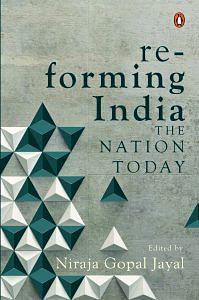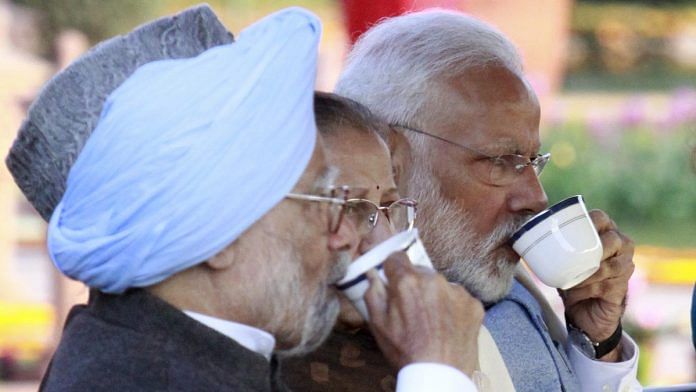With its campaign slogans ‘maximum governance, minimum government’ and ‘sabka haath, sabka vikas’, and repeated invocation of the ‘Gujarat Model’, once in power, the Narendra Modi government was widely expected to be a centre-right, market-friendly government that would prioritize economic growth and roll back or certainly underemphasize welfare schemes (Das 2017; Sharma 2013; Jha 2017).
Now as the government enters its final lap, the narrative has decisively shifted. Modi the ‘Vikas Purush’ is now being widely considered to have repositioned himself as the ‘Gareebon ka Neta’ (Jha 2018). Far from being an advocate of minimum government, the National Democratic Alliance (NDA), under Modi, argue many of his early supporters, has steered the welfarist path, launching scheme after scheme, thus repositioning the Bharatiya Janata Party (BJP) as a centre-left rather than a centre-right party (Das 2017; Jagannathan 2015; Dehijia 2018).
So did the NDA and Modi really have a welfare policy and vision? And beyond the headlines what perspective did the government bring to the welfare debate in India?
…
Failure to invest in state capacity was the UPA’s big failing. Ironically, for a government whose election promise was to improve efficiency and delivery, the NDA has fallen into exactly the same trap, leaving the welfare architecture in severe need of serious investments.
…
Education and Health
For a welfare politics that sought to root itself in a narrative of ‘empowerment’, health and education remain two areas where the government’s failures have been particularly glaring. Until the recent grand announcement of the National Health Protection (or Ayushman Bharat) both health and education failed to find place in this government’s welfare approach and surprisingly for a politics based on ‘empowerment’, these issues rarely made it to the political centre stage.
In the field of elementary education, the NDA came to power at an important juncture. After decades of investment in meeting the goal of universal education through expansion of education inputs, an approach that was accelerated and entrenched after the UPA misguidedly legislated for the Right to Education, the policy landscape had firmly shifted towards focusing on improving education quality. In fact, the importance of quality in education finds repeated mention in the finance minister’s budget speeches. However, having recognized the problem, this government has displayed little by way of imagination or ideas on how to solve the problem. Of course, committees have been set up but to little effect. The first National Education Policy never made it past the officialdom and as this essay goes to print, the second committee report is likely to meet the same fate.
The failure to develop a framework and vision for education is also indicative of this governments’ misdiagnosis of the problem of jobs and skills, which were at the heart of its political agenda. In this government’s policy articulation, Skill India and Make in India are policy goals that can be met through enhanced vocational training outside the school system. But the truth is that a significant number of India’s youth finish nearly eight years of schooling without acquiring even basic foundational skills. Available global evidence on the ability of short-term skilling programmes to bridge these foundational learning gaps is mixed, suggesting that any policy that wants to improve skilling and jobs must necessarily take a longer-term perspective and build a strong education foundation. This government has failed to recognize these critical links and instead limited its agenda of skilling to short-term trainings without a framework for improving education. The only visible and commendable shift made in elementary education policy through the NDA years has been an effort to measure learning outcomes in a more systematic way. The Niti Aayog has initiated a process of measuring learning outcomes through a school education quality index. The Ministry of Human Resource Development (MHRD) too has made efforts at monitoring learning outcomes more systematically. In 2017, the MHRD launched (and completed in record time) the National Assessment Survey. The ministry had committed to making the survey a biannual affair. Measuring a problem is the first step to resolving it. To this extent, the proliferation of measurement and indexes is a useful exercise. However, the challenge for education policy now lies in using this measurement to develop policy and improve action on the ground. In these last four years, the MHRD certainly has struggled to do just this. Importantly, the relationship between these different measurement tools developed and adopted by different, parallel government institutions remains unclear.
In the meantime, the action has shifted firmly to the states. Many states, Rajasthan, Haryana, Delhi, to name a few, have been actively experimenting with reforming their education systems. However, the lack of policy direction at MHRD has meant that its flagship education programme, the Sarva Shiksha Abhiyan (SSA) has hindered rather than aided progress. Most states are dependent on the SSA for accessing funding for learning-related activities. This is on account of the fact that state governments use a significant amount of their own resources for paying teacher salaries. However, the bulk of the funding through the SSA is linked to infrastructure-related activities—76 per cent in 2017–18. The two line items that focus specifically on fuelling learning-focused innovation—(innovation and learning enhancement programme) received less than 9 per cent of the SSA budget in 2017–18. Funding through these two streams is given relatively low priority. In times of financial stress, this is the one area that has seen the most cuts. In 2014–15, only 13 per cent of funds requested by the states for these activities were approved. This increased to 25 per cent in 2015–16 (Accountability Initiative, Budget Briefs, 2017 and 2018).
Finally, there has been little thought given to the role and design of the SSA to incentivize and facilitate a focus on improving learning. Experts have been arguing for the need to restructure SSA, introduce innovation funds and create a performance-financing window for untied Central government financing for elementary education (Banerji 2018; Aiyar 2018). But this perspective has not percolated into policy action and elementary education policy under the NDA is not different from the UPA, despite the stated focus on quality.
The government’s policy on health took an interesting turn in 2018 with the announcement of the National Health Protection Scheme (NHPS) or Ayushman Bharat in the budget. At the time of writing this essay (July 2018), the nuts and bolts of the scheme were still being fleshed out. A detailed commentary is therefore premature but it is worth asking whether the preconditions for a successful health insurance policy are in place. In many ways, the NHPS envisages a major significant architectural shift in health policy, pushing the government towards the role of a financer and a regulator rather than a service provider. But is India ready for this shift in place? At one level, the answer to this question will only be found in the actual design of the NHPS but experience with the precursor to NHPS, the Rashtriya Swasthya Bima Yojana (RSBY) and state insurance schemes tell a cautionary tale. A combination of factors needed to get regulation right, including supply side constraints (private hospital networks are not as wide as policymakers imagine and there are significant market failures that will likely constrain increasing supply), low awareness and enrolment, and perhaps, most importantly, the capacity to deal with complex regulatory requirements like fraud management and pricing, are simply not in place (Das 2017; Shah 2018; Rao 2018). Under these circumstances, the NHPS runs the risk of becoming the world’s largest, unregulated Public Private Partnership (Aiyar 2018).
…
The NDA came to power with a powerful mandate that offered a unique opportunity to structurally transform India. Even though welfare wasn’t a clearly stated priority in its first few years in government, the emphasis on delivery and efficiency coupled with the rhetoric of cooperative federalism did raise expectations of the possibility of a more efficient delivery architecture. But when it came to welfare, the agenda of transformation was caught in the government’s own contradictions and misdiagnosis of the core challenge. The result is that welfare delivery has been weakened and a unique opportunity to transform the welfare architecture through greater devolution lost. As the government readies for the polls, Modi’s welfare schemes are firmly on the political agenda but in sharp contrast to the political rhetoric of 2014, the ‘Gareebon ka Neta’ is going to go to the polls with exactly the same record that he accused the Congress-led UPA of: a polity of promises, and not performance (BJP manifesto).
 This excerpt from Yamini Aiyar’s essay ‘Maximum Schemes, Minimum Welfare’ in the book Re-Forming India has been published with permission from Penguin Random House India.
This excerpt from Yamini Aiyar’s essay ‘Maximum Schemes, Minimum Welfare’ in the book Re-Forming India has been published with permission from Penguin Random House India.




Ever-burgeoning population is the root cause of all problems. Why does THE PRINT not campaign for population control ?